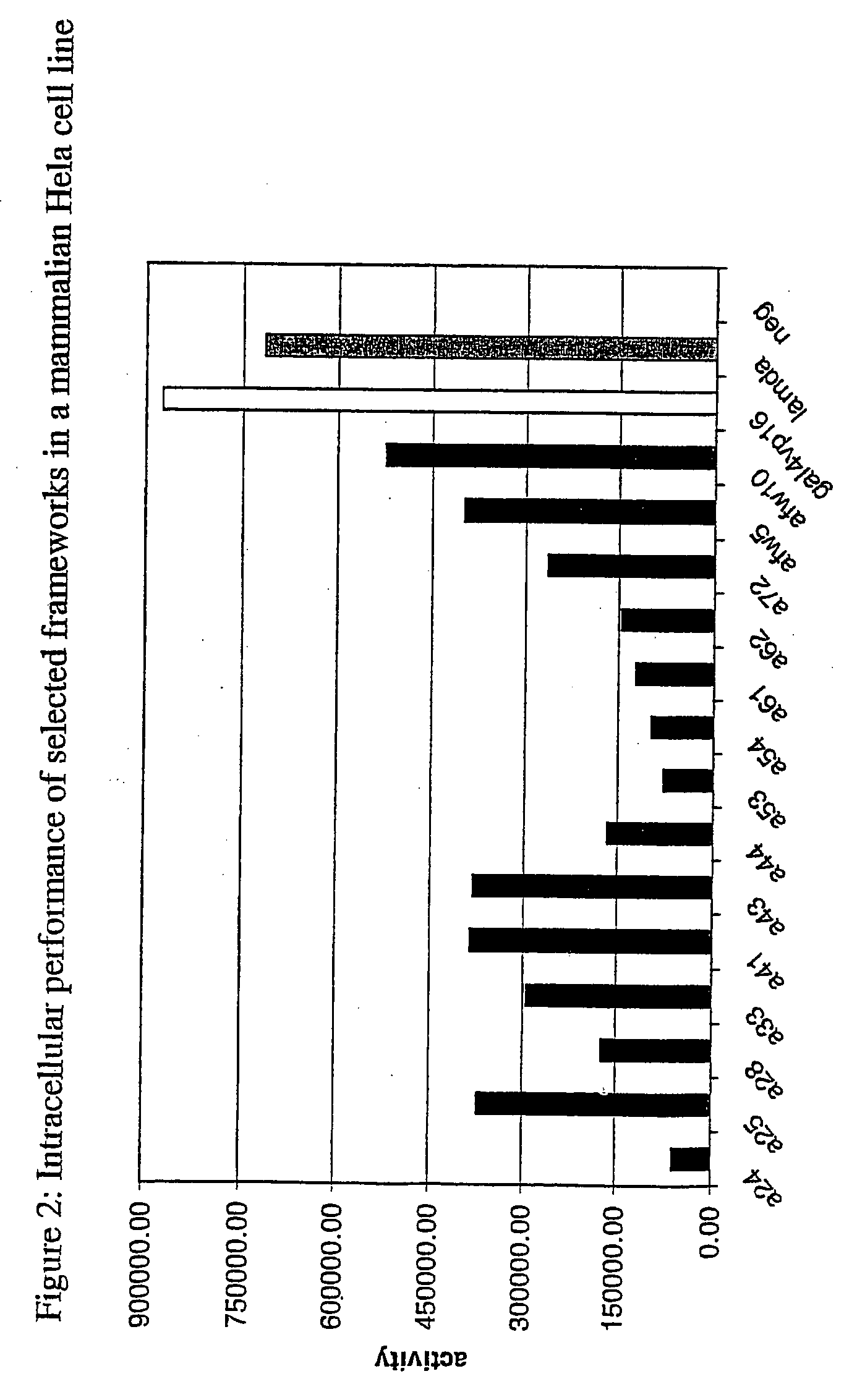Immunoglobulin frameworks which demonstrate enhanced statbility in the intracellular envioronment and methods of identifying same
a technology of immunoglobulin and framework, which is applied in the fields of protein chemistry, molecular biology, and immunology, can solve the problems of unstable antibody fragments, unstable antibody fragments, and inability to function inside the cell, and achieve the effect of high stability and solubility and superior stability and solubility
- Summary
- Abstract
- Description
- Claims
- Application Information
AI Technical Summary
Benefits of technology
Problems solved by technology
Method used
Image
Examples
example 1
[0159] Selection of Intrabody Frameworks Through Screening of a Human Library in the “Quality Control” System in Yeast
[0160] Screening with the “quality control” system for stable frameworks was essentially performed as described in detail by Auf der Maur (WO0148017, Auf der Maur 2001, each hereby incorporated by reference).
[0161] The plasmids for expression of the scFv-fusion constructs for screening in yeast were derived from pESBA-Act (Wörn, 2000). It contains the yeast TRP1 gene for transformation selection in S. cerevisiae and the 2 micron origin of replication to ensure high copy numbers. Moreover it has a constitutive actin promoter for strong expression and the GAL11 transcriptional termination sequence, separated by a multiple cloning site. For handling in bacterial systems, it also has a bacterial origin of replication and the amp resistance gene.
[0162] The Gal4 activation domain (AD amino acids 768-881) was originally amplified by PCR using pGAD424 (Clontech) as templa...
example 2
[0167] Evaluation of in Vivo Performance
[0168] a) In Yeast
[0169] For quantitative analysis of the performance of the selected frameworks in yeast (FIGS. 1 and 3), S. cerevisiae-strain Immuna LHB was transformed with the isolated scFvs as LexA-Gal4-AD-fusion constructs on the pESBA-Act2 vector by following a standard lithium acetate transformation protocol (Agatep, 1998). Following transformation, the cells were plated on drop-out plates (Trp). 2 ml overnight-cultures in drop-out medium (-Trp) were inoculated in duplicates from streaks containing several colonies and grown at 30° C. Cultures were diluted in 1 ml drop-out medium (-Trp) to an optical density at 600 nm (OD600) of 0.7. They were then grown at 30° C. for 2 h. For the assay, 100 μl cell culture were taken, mixed with 900 μl buffer, 45 μl Chloroform and 30 μl 0.1% SDS, vortexed and incubated at room temperature for 5 minutes. The color development was initiated by the addition of 0.2 ml ONPG (4 mg / ml) and stopped with 0.5...
example 3
[0174] Multiple Alignment and Analysis of the Sequence Comparison
[0175] To elucidate the general pattern of framework sequences suitable for intracellular applications, all positive clones (i.e. those that grow under selective conditions in the quality control system) were isolated and the part coding for the scFvs was sequenced. Subsequently, the scFv sequences were divided in their light and heavy-chain component to allow alignment of the respective domains (Tables 1 and 2) according to the structural adjusted numbering scheme of immunoglobulin domains by Honegger (2001).
[0176] To allow evaluation of the obtained data, an alignment representing the unselected library was generated (Table 3). In order to obtain unselected sequences, the library was transformed in E. coli cells which do not express the scFv-genes and clones were picked at random for plasmid isolation and sequencing of the scFv-sequence. The library covers the human antibody repertoire as expected and thus has no b...
PUM
| Property | Measurement | Unit |
|---|---|---|
| temperatures | aaaaa | aaaaa |
| optical density | aaaaa | aaaaa |
| temperature | aaaaa | aaaaa |
Abstract
Description
Claims
Application Information
 Login to View More
Login to View More - R&D
- Intellectual Property
- Life Sciences
- Materials
- Tech Scout
- Unparalleled Data Quality
- Higher Quality Content
- 60% Fewer Hallucinations
Browse by: Latest US Patents, China's latest patents, Technical Efficacy Thesaurus, Application Domain, Technology Topic, Popular Technical Reports.
© 2025 PatSnap. All rights reserved.Legal|Privacy policy|Modern Slavery Act Transparency Statement|Sitemap|About US| Contact US: help@patsnap.com



